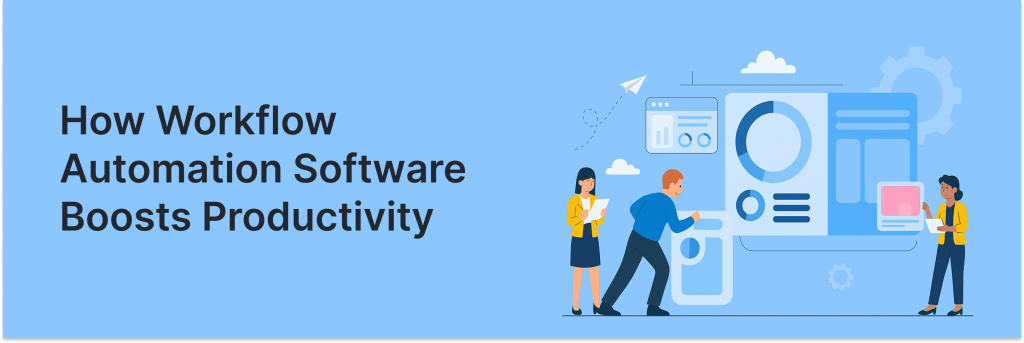
Every business wants to be more productive – but how do you get there without burning out your team or overloading your budget? Workflow automation software offers a powerful solution by eliminating repetitive, manual tasks and freeing up time for higher-value work. It doesn’t just help teams move faster – it helps them work smarter.
This article explores some of the best workflow automation tools out there for various businesses and how they can help boost productivity in different departments. If you’re looking to improve output, reduce operational friction, and increase your team’s focus, automation is your next best step – and we’ll show you how to leverage it effectively.
TL;DR – Best Workflow Automation Software
- FuseBase – Combines automation, collaboration, and branded client portals with AI assistance.
- Tallyfy – Step-based workflow builder with approval routing and documentation features.
- Trello + Butler – Kanban boards with built-in Butler rules for easy, no-code task automation.
- ClickUp – Highly customizable platform with tasks, docs, chat, and automation rules.
- Pipefy – Automates service requests, onboarding, and approvals with process templates and SLA tracking.
- Nifty – Unites project tracking, chat, and workflow automations in a clean, all-in-one interface.
- Notion + Automation Tools – Flexible workspace for documentation and projects, extended with automations via Zapier, Make, or APIs.
What is Workflow Automation Software?
Workflow automation software enables businesses to boost productivity by eliminating time-consuming, repetitive tasks from daily operations. It connects tools, teams, and data through predefined sequences that automatically trigger actions such as sending follow-up emails, updating CRM records, assigning tasks, or generating reports. Instead of relying on manual input and follow-ups, the software ensures that processes run smoothly and consistently in the background.
By reducing human error and improving response times, workflow automation helps teams stay focused on high-impact, strategic work rather than getting bogged down in routine activities. Most platforms also offer visual builders, integrations with popular tools, and real-time tracking – making it easier for businesses of all sizes to optimize how work flows across departments. In a fast-paced digital environment, adopting workflow automation software is a crucial step toward building a more agile, scalable, and efficient organization.
Main Benefits of Workflow Automation Software
Workflow automation software helps teams do more in less time by optimizing how work gets done. Here’s how businesses are seeing measurable productivity gains:
- Fewer Manual Tasks, More Focused Work. Automation eliminates routine admin work, allowing teams to concentrate on higher-value projects.
- Streamlined Communication. Automated task assignments and notifications keep everyone aligned without the need for constant status meetings or check-ins.
- Faster Project Completion. Workflows move automatically from one stage to the next, cutting delays and helping teams hit deadlines consistently.
- Smarter Resource Allocation. Managers can identify slow points and reassign work based on real-time insights from automated reporting.
- Employee Satisfaction. By removing tedious work, automation reduces burnout and creates a more rewarding work experience.
How You Can Use Workflow Automation Software
1. Task Assignment and Delegation
When a form is submitted or a project hits a new phase, workflow automation can instantly assign tasks to the right team members with deadlines, cutting back on wasted time and confusion.
2. Content Review and Publishing
Streamline content workflows by automating review requests, publishing approvals, and pushing content live, allowing content teams to move faster without skipping quality checks.
3. Internal Request Handling
IT, HR, or admin requests often get buried in inboxes. With automation, these requests are categorized, assigned, and tracked automatically, improving internal service delivery and response time.
4. Lead Management and Nurturing
New leads from forms or integrations can be assigned to sales reps, enrolled in email sequences, or tagged in a CRM, helping your sales team respond faster and follow up consistently.
5. Meeting Follow-Up Automation
Automatically generate task lists, send recap emails, and assign follow-ups after meetings using integrated calendars and notes. This keeps momentum high and reduces missed action items.
Top 7 Workflow Automation Software
1. FuseBase – Best for Client-Facing Teams and Service-Based Workflows

FuseBase blends automation, collaboration, and content sharing in one powerful platform. Teams can set up automations triggered by task updates, file uploads, or form submissions. Built-in AI helps generate summaries, draft responses, and streamline communication. Its portal builder allows you to deliver a branded, interactive experience to clients without additional tools.
Key Features:
- Visual no-code automation builder for tasks, forms, and files
- Customizable client portals with granular permission settings
- Built-in AI for task summaries, automation setup, and content
- Document collaboration with e-signatures and smart folders
- Templates and reusable workflow blocks
Pros:
- Automates internal and client-facing workflows from one place
- Reduces busywork with AI-powered automations
- Great for growing teams that need branding, structure, and flexibility
- Fast deployment and intuitive interface
Why choose FuseBase:
FuseBase is the top choice for teams that need to automate both internal and external processes—especially agencies, consulting firms, legal professionals, and service providers. It streamlines complex client workflows with branded portals while eliminating manual work with smart automations and AI assistance.
2. Tallyfy – Best for Approval-Based and Compliance Workflows

With step-by-step templates, deadline tracking, and external user access, Tallyfy brings structure and clarity to every process. It’s especially useful when approvals span teams or departments and need to be documented for auditing purposes.
Key Features:
- Step-based process builder
- Approval routing with custom logic
- Role-based access for clients or external reviewers
- Integration with Zapier and custom APIs
Pros:
- Transparency and accountability in multi-user workflows
- Designed for documentation-heavy processes
- Suitable for external collaboration in sensitive industries
Why Choose Tallyfy:
Tallyfy is built for industries that rely on consistent, traceable workflows – such as healthcare, legal, and finance. It’s perfect for managing multi-step approvals, onboarding processes, and compliance documentation.
3. Trello + Butler – Best for Small Teams with Simple Task Flows
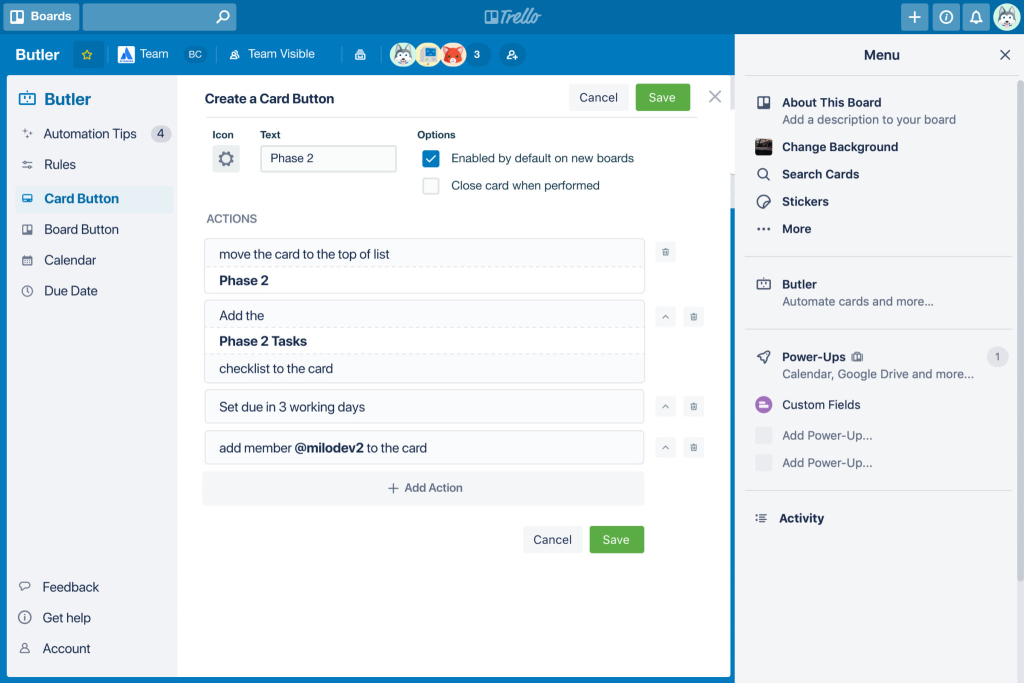
Trello uses cards and boards to visually manage tasks. The built-in Butler tool allows users to automate common actions—like moving cards, setting due dates, or notifying teammates – without needing coding knowledge. For straightforward workflows, it’s quick, effective, and collaborative.
Key Features:
- Drag-and-drop Kanban boards
- Butler automation engine with pre-built commands
- Power-Ups for extended functionality (calendar, timeline, etc.)
- Integrations with Google Drive, Slack, and more
Pros:
- Easy to learn and use
- Automation setup with natural language rules
- Great for simple team workflows
- Strong free plan
Why Choose Trello:
Trello is a great pick for small, fast-moving teams that want simple task automation without the learning curve. It’s ideal for startups, freelancers, or departments with basic workflow needs.
4. ClickUp – Best for All-in-One Project and Workflow Management

ClickUp combines project management with built-in automation rules and custom workflows. From assigning tasks based on form entries to automatically changing statuses and sending alerts, it’s powerful and flexible enough for teams in product, design, marketing, or operations.
Key Features:
- Custom workflows with task triggers and automation rules
- Built-in docs, chat, time tracking, and dashboards
- Integrates with Slack, Google Workspace, Zoom, and more
- Goal tracking, workload views, and templates
Pros:
- Combines many tools into one platform
- Highly customizable for different industries
- Automation options cover a wide range of use cases
- Affordable entry-level plans with advanced features
Why Choose ClickUp:
ClickUp is ideal for teams seeking a central hub for everything – tasks, docs, collaboration, and automation. It helps remote and cross-functional teams reduce app-switching and increase productivity.
5. Pipefy – Best for Structured Processes and Operational Teams
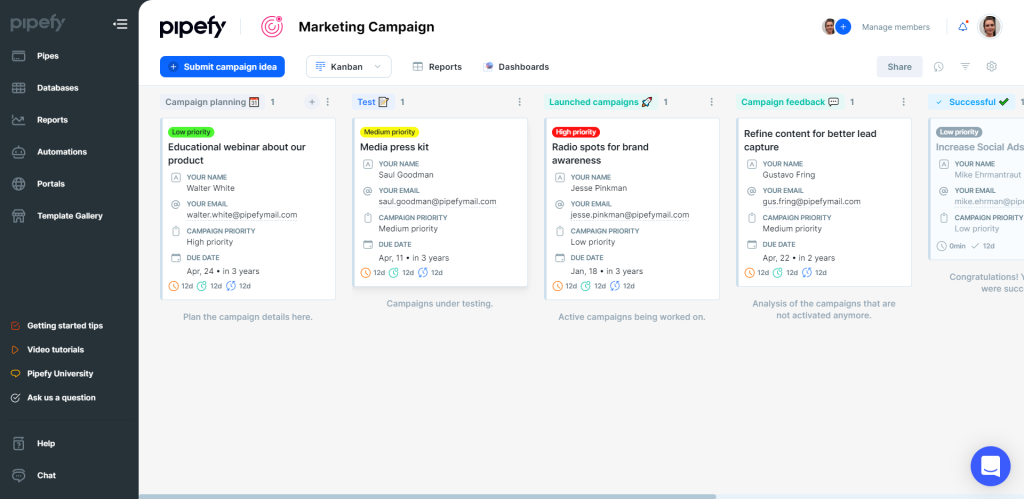
Pipefy enables users to create workflows using forms, rules, and triggers. From handling service desk requests to onboarding and expense approvals, it allows non-technical users to automate repetitive steps and standardize operations across teams.
Key Features:
- Process templates and conditional workflows
- SLA tracking and deadline enforcement
- Form builder with automated routing
- Integrations with Slack, Google Workspace, and ERPs
Pros:
- Simplifies approval chains and internal service requests
- Great fit for compliance-heavy or operationally complex teams
- Quick to implement with minimal training
- Strong customer support
Why Choose Pipefy:
Pipefy is a strong choice for operations, HR, finance, or procurement teams who deal with structured, form-driven processes. It brings discipline and accountability to workflows without requiring deep technical know-how.
6. Nifty – Best for Managing Projects with Built-In Automation and Team Collaboration
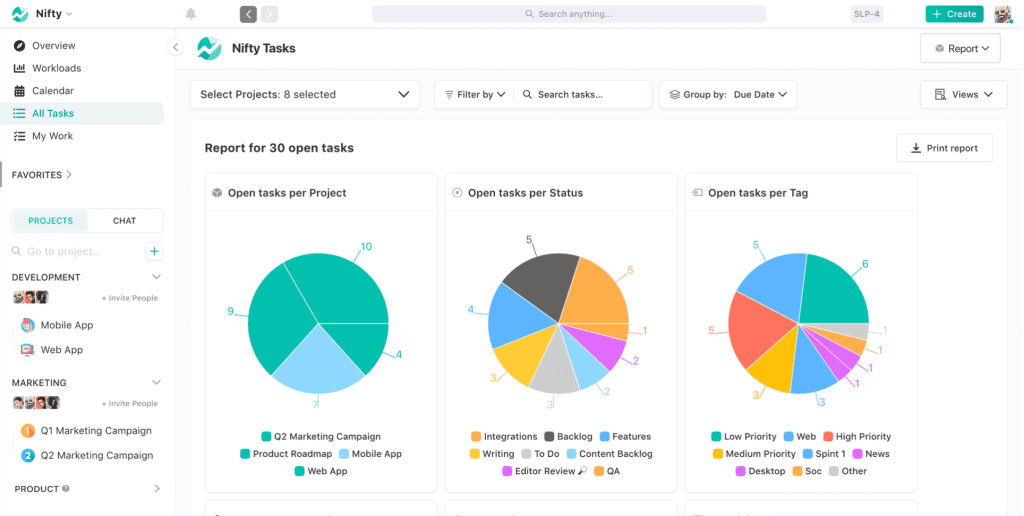
Nifty brings together task management, discussions, documents, milestones, and time tracking under one roof. Its automation engine allows users to build rules that trigger task creation, status changes, reminders, and assignments based on custom workflows. With built-in chat, file storage, and reporting, it reduces the need for additional platforms.
Key Features:
- Kanban, list, and calendar views for tasks
- Workflow automations for repetitive actions
- Built-in team chat and project discussions
- Milestone tracking and progress reporting
- Document sharing and in-task file comments
Pros:
- Combines automation, collaboration, and project tracking
- Clean interface and fast onboarding
- Useful templates for marketing, dev teams, and agencies
Why Choose Nifty:
Nifty is an ideal choice for teams that want to combine project management, team communication, and workflow automation in one sleek interface. It’s particularly useful for marketing, creative, and software teams that need to manage timelines, feedback, and progress without switching between multiple tools.
7. Notion + Automation Tools – Best for Knowledge-Driven Teams with Custom Needs
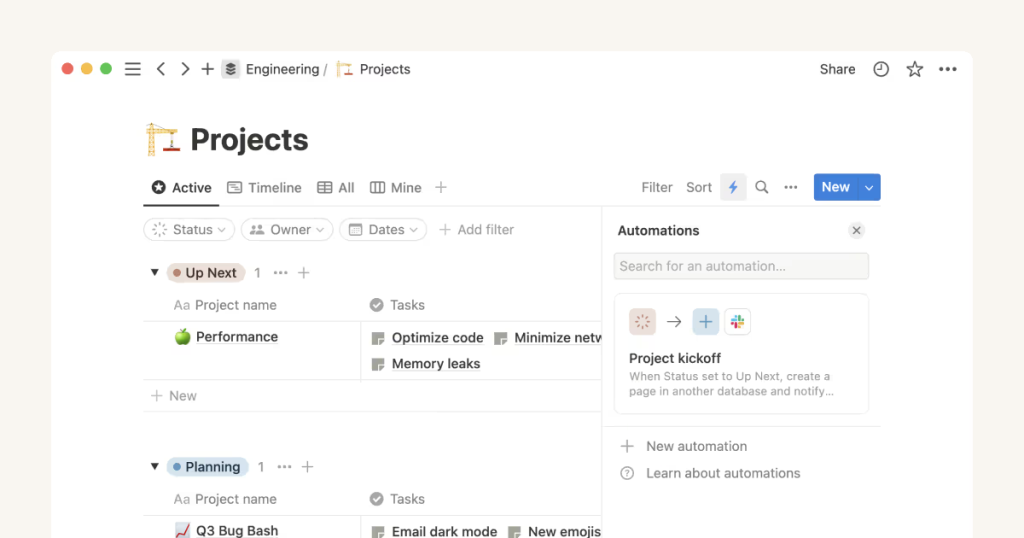
Notion centralizes notes, projects, databases, and wikis. While it doesn’t offer native automation (yet), it becomes a dynamic workflow tool when integrated with third-party platforms. You can trigger actions based on form fills, database updates, or external submissions.
Key Features (via integrations):
- Task and content management databases
- Cross-tool automation via Zapier, Make, or APIs
- Real-time collaboration and comments
- Supports rich content (video, docs, embeds)
Pros:
- Incredibly customizable
- Perfect for async and remote work
- Blends documentation and workflow seamlessly
Why Choose Notion:
Notion is ideal for teams that need a flexible workspace and want to extend it into automated workflows using external tools like Zapier or Make. It works well for content teams, knowledge management, and hybrid work setups.
Conclusion: The Best Workflow Automation Tool for Productivity in 2025
In today’s fast-moving work environment, boosting productivity isn’t just about working harder – it’s about working smarter. The right workflow automation software reduces bottlenecks, minimizes manual errors, and frees up time for meaningful, high-impact work.
While each tool on this list excels in different areas, FuseBase emerges as the top choice for teams that want to automate deeply and collaborate effectively – especially in client-facing scenarios. With its blend of AI-assisted automations, branded client portals, and task management, FuseBase delivers real productivity gains without sacrificing user experience or flexibility.
If your goal is to build a faster, more responsive, and more client-aligned operation in 2025, FuseBase is the workflow automation platform to lead that transformation.